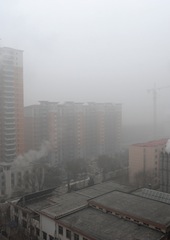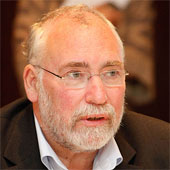London and Beijing: A Polluted Tale of Two Cities
How Beijing’s tale proceeds from here will determine what kind of planet we leave behind.
November 12, 2013

The term “airpocalypse” has been widely and fittingly applied to Beijing. Images of barely visible skylines, masked citizens and uncannily quiet streets, where pollution levels surge beyond dangerous to “off index,” have shown the pervasiveness and virulence of the problem.
In many respects, the tale of Beijing is a variation on industrialization themes that go back to the origins of the industrial revolution. A “green” industrial revolution has never occurred anywhere on Earth.
Though comparisons can be tricky, Beijing is roughly to the 21st century what London was to the 19th — the capital of the world’s fastest rising industrial power of its time.
The risk of double standards
But death by outdoor air pollution in the UK was not solely a plague of industrializing Victorian England or Charles Dickens’ London. Suffocating smog, or “peasoupers” as they were often called, gripped London and claimed lives until at least the 1950s.
The Great Smog of 1952 is believed to have caused as many as 4,500 deaths in one week at its peak and around 12,000 in the following months. The West therefore should be very careful when chastising China (and other emerging economies) over their pollution levels at the risk of being guilty of double standards.
In 19th-century London, coal was the main source of smog. It was burned in large quantities to heat homes and other buildings. By the mid-20th century, other noxious emissions from industry and vehicles were added to the mix.
Today, China consumes close to half the world’s coal, which is still the main source of energy for the country.
In and around Beijing, a large population and high concentration of industry – combined with the hilly topography surrounding the city – push the levels up to and beyond “dangerous” at certain times of the year.
Killer air pollution
Killer air pollution is a blatant example of the interdependence between the three dimensions of sustainable development: the environmental, economic and social.
Although they vary somewhat depending on the source, the numbers speak louder and more urgently than any of the abstract theories of environmental degradation, social inequity and economic growth.
At the turn of the 21st century, the World Bank estimated disease and death from air pollution in China represented annual losses of 2-3% of GDP.
According to the more recent Global Burden of Disease 2010 report, published by a consortium that includes Harvard University, Johns Hopkins University, the University of Tokyo and the World Health Organization, outdoor air pollution was a major contributor to around 1.2 million premature deaths in 2010 in China.
During the pollution extremes of early 2013, Beijing hospitals saw an increase in admittance of people with acute respiratory illnesses. Retailers benefited from spikes in sales of air purifiers, but few others did.
Rethinking economic development
In much of the economic development literature, growth has been hailed as the ultimate cure-all. In reality, it is seldom a panacea for the world’s ills, much less the antidote to environmental pollution.
Countries need to grow, so it was argued, and pass through the “dirty” phases of industrialization. Only then could they achieve a certain level of prosperity where incentives, public demand and financial or technological means could coalesce to bring pollution levels down.
This “theory” was buttressed in the 1990s by economists who claimed to have found empirical evidence of this pattern in different countries. They dubbed it the Environmental Kuznets Curve – or EKC.
The EKC shows an inverted U-shaped relationship between pollutant levels and income per capita, as a proxy for economic growth. Environmental degradation increases as incomes rise, up until a turning point when degradation begins to decrease but incomes continue to rise.
Then, economic growth, the independent variable, leads to improvements in production technology, the introduction of abatement technology and increasing public demand for environmental quality.
No automatism
Over the past decade, the theory and empirical evidence for the EKC have been critiqued on a number of fronts, for instance with regard to poor data and modeling techniques. Yet, the biggest failing is that the results from empirical studies do not confirm a direct causal relationship between incomes per capita and pollution levels.
Economic growth does not automatically lead to improvements in environmental quality after a given level of growth has been achieved. Emissions reductions — be they air, water or land pollutants – are achieved only through investment, government regulation and changes in behavior and not by growth in itself.
The people of Beijing who have been calling for government action to reduce outdoor air pollution represent a broad range of income brackets. When children are confined indoors for days and weeks on end and when they begin suffering respiratory problems, parents – regardless of their income levels — worry and call for change.
This is what the growing number of anti-pollution demonstrations in Beijing and other Chinese cities illustrates. Beyond the call for government action, individual parental action varies according to income, reflecting the interdependence between the environmental, economic and social.
The rich just leave
While face masks may be affordable, quality air purifiers, which can cost up to $3,000 in Beijing, are too expensive for many people.
Elite local and international schools are investing in new infrastructure to provide students with covered sporting facilities, including high-quality air purifying systems. For example, the International School of Beijing invested $5.7 million in large indoor sports facilities.
The final defense against the smog is to leave. Just as wealthy Londoners escaped the choking peasoupers by going to their homes in the countryside, more and more wealthy Chinese and expatriates simply leave Beijing. People with low incomes, however, do not have that choice — they stay and choke.
Pollution exacerbates social inequality as it causes greater suffering amongst the poor. They are more exposed and often unable to pay to prevent or to treat the resulting illnesses.
As goes London, so goes Beijing
In 1858, a sitting in the House of Commons in London had to be canceled as MPs could not abide the stench of dying fish emanating from the River Thames. One hundred years later – fifty years ago – the River Thames itself that was declared biologically dead, no longer able to support any life.
Due to notable efforts in recent decades, the Thames has come back to life. Today, it supports 125 fish species and 400 types of invertebrate. They in turn contribute to biodiversity by providing food for a wide variety of bird species.
The tale of polluted London has been a very long one, spanning well over a century. Beijing cannot take that long; it would be a catastrophe for China and indeed for the whole planet.
But rather than chastise Beijing with a Western holier-than-thou air, we all need to cooperate in recognizing that economic development desperately needs to be decoupled from environmental damage and destruction and taking appropriate steps.
The next chapter of the tale of Beijing will be one of the most critical narratives of our times. It will determine the kind of planet in which we will live and the one we will bequeath to future generations.
It behooves not only the citizens of Beijing, nor indeed the citizens of all of China, but all global citizens to ensure that the conclusion to this tale will be a happy one.
Takeaways
The West should be careful when chastising China on pollution levels, lest they be guilty of double standards.
Beijing is to the 21st century what London was to the 19th – the world’s fastest rising industrial capital.
A “green” industrial revolution has never occurred anywhere on Earth.
Outdoor air pollution in the UK gripped London and claimed lives until at least the 1950s.
Killer air pollution drives home abstract theories of eco degradation, social inequity and economic growth.
Quality air purifiers, which can cost up to $3,000 in Beijing, are too expensive for many people.
One defense against smog is to leave. Like rich Londoners escaping to the country, wealthy Beijingers simply leave.
Unlike the rich, city-dwellers with low incomes do not have the option to flee smog; they stay and choke.
The tale of polluted London has been a very long one, spanning well over a century. Beijing cannot take that long.
Authors

Heidi Strebel
Heidi Strebel works as a researcher for the Global CEO Center at IMD

Jean-Pierre Lehmann
Emeritus Professor of International Political Economy at the IMD Business School [Switzerland] Jean-Pierre Lehmann (1946-2017) was an emeritus professor of international political economy at IMD in Lausanne, Switzerland. He also served currently a visiting professor on the Faculty of Business and Economics at Hong Kong University. He was also a Contributing Editor at The Globalist, […]
